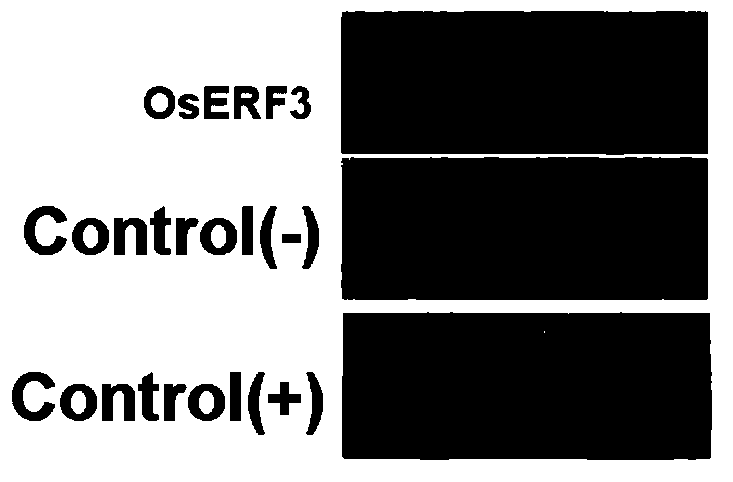Ethylene responsive factor gene OsERF3 and application of promoter thereof in regulating and controlling development of rice roots
An ethylene response factor, rice root technology, applied in the field of plant genetic engineering, can solve problems such as unclear mechanism of action
- Summary
- Abstract
- Description
- Claims
- Application Information
AI Technical Summary
Problems solved by technology
Method used
Image
Examples
Embodiment 1
[0040] Embodiment 1: Construction of OsERF3 overexpression vector
[0041] For the gene OsERF3 required by the present invention, mainly by RT-PCR method (see: J. Sambrook, EF Fritsch, T Mani Artis, translated by Huang Peitang, Wang Jiaxi, etc., Molecular Cloning Experiment Guide (Third Edition) ), Beijing, Science Press, 2002 edition) was amplified to obtain a specific sequence of the OsERF3 gene. The specific operation is as follows:
[0042] 1) Extract the RNA from the seedling leaves of the rice variety "Zhonghua 11" (see Genetic Resources Source Disclosure Table-1). The RNA extraction reagent is Trizol Extraction Kit from Invitrogen Company (see the kit instruction manual for specific operation steps) ;
[0043] 2) The steps to synthesize the first strand of cDNA by reverse transcription in RT-PCR are as follows: ① Prepare mixed solution 1: 4 μg of total RNA, 2U of DNaseI, 1 μl of 10xDNaseI buffer, add DEPC (diethyl pyrocarbonate, a strong inhibitor of RNase ) Treat wa...
Embodiment 2
[0051] Embodiment 2: Construction of OsERF3 artificial small interfering RNA vector
[0052] 1) Using the NW55 plasmid as a template, first amplify three sets of PCR reactions with primers I miR-s and III miR*s, II miR-a and IV miR*, II miR-a and III miR*s (PCR system and program Consistent with the PCR system and procedures described in Example 1).
[0053] 2) Take 0.5 μl of PCR products from the above 3 groups of PCR reactions as a template, and amplify with primers G-11491' and G-11494' (PCR system and program are consistent with the PCR system and program described in Example 1 ; G-11491' and G-11494' were synthesized by Sangon Bioengineering (Shanghai) Co., Ltd.).
[0054] The primers used to construct the artificial small interfering RNA vector are:
[0055] I miR-s: 5'-AGTAAAGTAAGGATGCGTTGCTTCAGGAGATTCAGTTTGA-3'
[0056] II miR-a: 5'-TGAAGCAACGCATCCTTACTTTACTGCTGCTGCTACAGCC-3'
[0057] III miR*s: 5’-CTAGCATCGCTTCCTTACTTTATTCCTGCTGCTAGGCTG-3’
[0058] IV miR*a: 5'-T...
Embodiment 3
[0064] Embodiment 3: The vector construction of OsERF3 promoter fusion reporter gene GUS
[0065] 1) Extract the total DNA from the leaves of the rice variety "Zhonghua 11" ((see Genetic Resources Source Disclosure Table-1). The DNA extraction method is the CTAB method (Zhang et al., genetic diversity and differentiation of indica an japonica rice detected by RFLP analysis , 1992, Theor Appl Genet, 83, 495-499), using the total leaf DNA as a template, and using the promoter amplification primers to amplify the ERF3 promoter sequence (the PCR system and program are consistent with the PCR system and program described in Example 1) .
[0066] The primers used to construct the vector of the promoter fusion reporter gene GUS are:
[0067] ERF3 promoter-F1:5'-CGCGGATCCGCTAGCAGCGCCTGGTACAT-3'
[0068] ERF3 promoter-R1:5'-ACGCGTCGACGTGTTTTGGGAGGTTGGGTT-3'
[0069] The cDNA sequence of the finally obtained OsERF3 gene promoter fusion reporter gene GUS is shown in SEQ ID NO:3.
[0...
PUM
 Login to View More
Login to View More Abstract
Description
Claims
Application Information
 Login to View More
Login to View More - R&D
- Intellectual Property
- Life Sciences
- Materials
- Tech Scout
- Unparalleled Data Quality
- Higher Quality Content
- 60% Fewer Hallucinations
Browse by: Latest US Patents, China's latest patents, Technical Efficacy Thesaurus, Application Domain, Technology Topic, Popular Technical Reports.
© 2025 PatSnap. All rights reserved.Legal|Privacy policy|Modern Slavery Act Transparency Statement|Sitemap|About US| Contact US: help@patsnap.com



